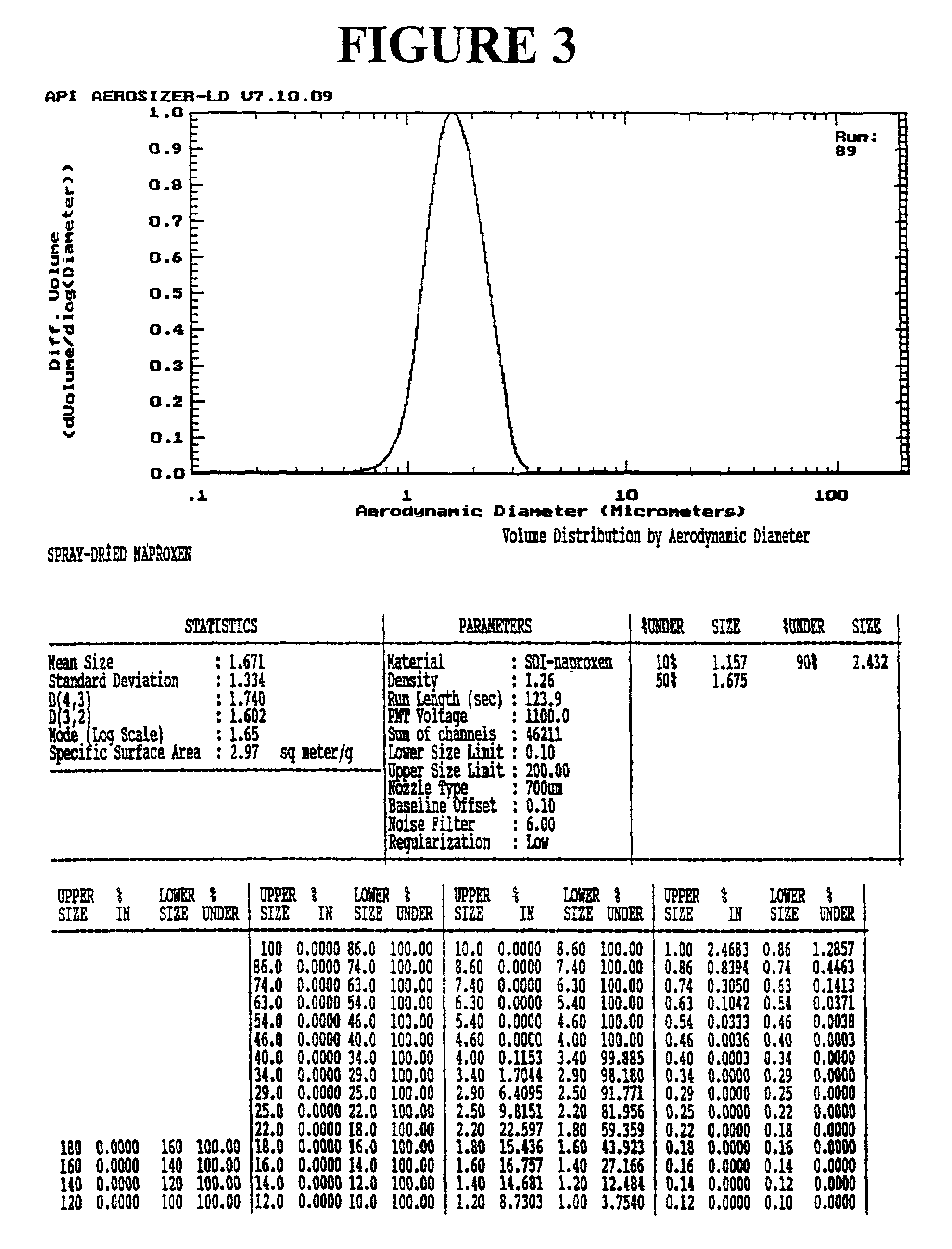Dry powder aerosols of nanoparticulate drugs
a technology of nanoparticulate drugs and aerosols, which is applied in the directions of aerosol delivery, dispersion delivery, powder delivery, etc., can solve the problems of poor oral administration candidates of modem protein drugs, unstable modem protein drugs in the acidic gastric environment or rapid decomposition, and poor ability of the digestive tract to accept oral administration, etc., to achieve easy dissolution, improve the dissolution rate of water-insoluble drugs, and improve the effect of aerosolization
- Summary
- Abstract
- Description
- Claims
- Application Information
AI Technical Summary
Benefits of technology
Problems solved by technology
Method used
Image
Examples
example 1
[0094]The purpose of this example was to demonstrate the ability to aerosolize a concentrated nanoparticulate dispersion in an ultrasonic nebulizer which incorporates a fine mesh screen in its design. An additional purpose of this example was to demonstrate that a therapeutic quantity of a concentrated nanoparticulate corticosteroid can be aerosolized in a very short period of time; e.g., two seconds or less.
[0095]Two different nanoparticulate dispersions of beclomethasone dipropionate (BDP) (1.25% and 10% BDP) were aerosolized using an ultrasonic nebulizer (Omron NE-U03 MicroAir®). The nebulizer generated droplets on a piezoelectric crystal and extruded them through a screen which contains ultrafine laser-drilled holes, producing an aerosol which has a very narrow particle size distribution in the range of approximately 1-5 μm. The device was connected to an Andersen cascade impactor with a flow rate at 28.3 liters per minute. For each formulation, the nebulizer was actuated for tw...
example 2
[0100]The purpose of this example was to demonstrate aerosolization of a nanoparticulate dispersion using a using a jet nebulizer (Circulaire®, Westmed, Inc., Tucson, Ariz.), which can produce aqueous droplets in the size range of 0.5-2.0 μm. Such droplet sizes are suitable for delivery to the alveolar region of the lung, i.e., deep lung delivery.
[0101]A nanoparticulate dispersion of BDP was prepared by wet milling micronized drug substance in an aqueous tyloxapol surface modifier solution until a satisfactory particle size distribution had been obtained. The formulation was evaluated by light scattering methods (Microtrac UPA, Leeds & Northrup) and was found to have a mean particle size of 139 nm, with 90% of the particles being less than 220 nm (volume statistics).
[0102]The delivery performance of the BDP / surface modifier dispersion in a jet nebulizer was evaluated as follows: Approximately 3.5 ml of the BDP / surface modifier dispersion (2 mg / ml) was added to the nebulizer bowl, an...
example 3
[0107]The purpose of this example was to demonstrate the preparation of a nanoparticulate dry powder for use in a DPI.
[0108]40.0% (w / w) naproxen, 4.00% (w / w) PVP K29 / 30 (a surface modifier), and 56.0% (w / w) deionized water were milled with 500 μm SDy-20 polymeric media for 7.5 hours to achieve a mean particle size of 254 nm, with 90% of the particles having a size of less than 335 nm. The material was diluted to 20% (w / w) naproxen and further milled with 50 μm SDy-20 media for a period of 6 hours to yield a mean particle size of 155 nm, with 90% of the particles having a particle size of less than 212 nm. The nanoparticulate dispersion was then diluted to 2% (w / w) naproxen with sufficient quantities of Sterile Water for Injection. The suspension was then spray-dried using a Yamato GB-22 operating with the following parameters:
[0109]
Inlet Temp.:130°C.Outlet Temp.:71-76°C.Drying Air:0.37m3 / min.Atom. Air:2M PaPump Speed:ca. 8.4mL / min.
[0110]The resultant nanoparticulate powder possessed...
PUM
| Property | Measurement | Unit |
|---|---|---|
| solubility | aaaaa | aaaaa |
| particle size | aaaaa | aaaaa |
| diameter | aaaaa | aaaaa |
Abstract
Description
Claims
Application Information
 Login to View More
Login to View More - R&D
- Intellectual Property
- Life Sciences
- Materials
- Tech Scout
- Unparalleled Data Quality
- Higher Quality Content
- 60% Fewer Hallucinations
Browse by: Latest US Patents, China's latest patents, Technical Efficacy Thesaurus, Application Domain, Technology Topic, Popular Technical Reports.
© 2025 PatSnap. All rights reserved.Legal|Privacy policy|Modern Slavery Act Transparency Statement|Sitemap|About US| Contact US: help@patsnap.com



